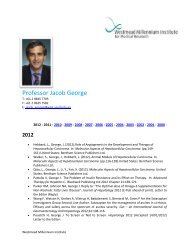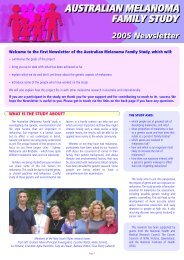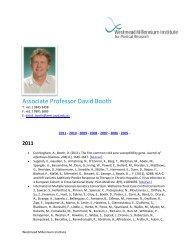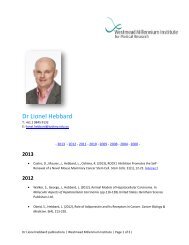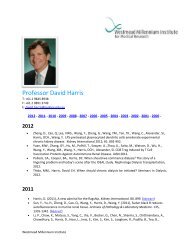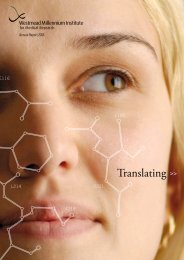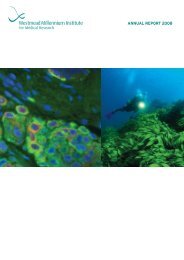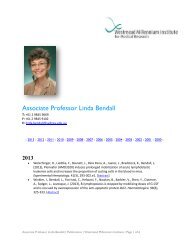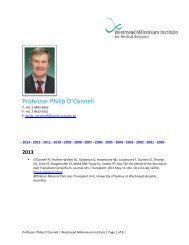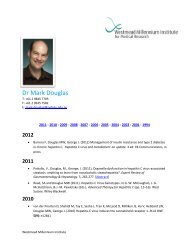Annual Report 2005 - Westmead Millennium Institute
Annual Report 2005 - Westmead Millennium Institute
Annual Report 2005 - Westmead Millennium Institute
You also want an ePaper? Increase the reach of your titles
YUMPU automatically turns print PDFs into web optimized ePapers that Google loves.
Cognitive neuroscience and the<br />
emotional brain<br />
Researchers in this program aim to identify and explore links<br />
between brain function, cognition and emotion by focussing on<br />
how the brain determines what is and what is not significant. Using<br />
fMRI, ERP’s and new measures of brain connectivity, researchers<br />
aim to identify the location of brain networks for perception of<br />
emotion (fear, anger, disgust, happy and sad). Initial results indicate<br />
there are specialised networks for emotions associated with our<br />
survival, such as fear.<br />
Supported by a prestigious Pfizer Fellowship, A/Prof Lea Williams<br />
and her team are focussing on functional brain connectivity in<br />
relation to emotional brain function, other sources of significance<br />
and the “disconnections” which define psychiatric illnesses. This<br />
research program also aims to evaluate the effectiveness of<br />
pharmaceutical intervention in restoring functional brain connectivity<br />
in complex brain disorders. Other research involves investigating<br />
age and gender differences in emotional brain function and<br />
cognition. Results from this research may provide insights as to<br />
gender differences in vulnerability to emotion-related disorders such<br />
as psychosis, PTSD and ADHD as well as the age- related process<br />
of cognitive decline.<br />
Neuroscientists are increasingly willing to speculate about<br />
consciousness, and identifying the neural mechanism of conscious<br />
experience is important in elucidating the factors that distinguish<br />
humans from primates. The study of non-conscious emotion<br />
perception is also a central step in understanding the mechanisms<br />
of anxiety disorders. Researchers in the Brain Dynamics Centre<br />
are integrating a range of neuroimaging techniques to<br />
comprehensively understand the neural mechanisms of conscious<br />
and unconscious processing.<br />
A significant ARC Linkage Grant enabled the Brain Dynamics<br />
Centre to collaborate with researchers from University of Sydney<br />
and University of NSW to integrate brain imaging with genetics. The<br />
“Development of integrated biological markers of brain function”<br />
collaboration has enabled new projects to be established into the<br />
identification of genetic polymorphisms contributing to variation in<br />
brain function; Prediction of response to antidepressant treatment<br />
in major depressive disorder; and the integration of genotypes with<br />
phenotypic data to develop neuropsychological, EEG/ERP and MRI<br />
profiles of known genotypes.<br />
Post traumatic and stress<br />
Post traumatic Stress Disorder (PTSD) is the most common<br />
traumatic psychiatric disorder to emerge after trauma exposure.<br />
Researchers are investigating the identification of temporal and<br />
biological markers for PTSD and the mechanisms of trauma and<br />
stress and how these are related to life events.<br />
PTSD and depression often present with similar symptoms and a<br />
lack of precise guidelines for diagnosis lead to increased chance of<br />
malingering. Research conducted in <strong>2005</strong> involved investigations<br />
into identifying markers for biological assessment to objectively<br />
identify and index PTSD. Further research being conducted in<br />
collaboration with both Australian and American groups aims to use<br />
EEG to determine if PTSD is a disorder of low approach motivation<br />
(similar to depression) or a disorder of high withdrawal motivation<br />
(like anxiety). Orienting mechanisms underlie important survival<br />
functions from diverting attention to significant or novel stimuli to<br />
avoiding harm from aversive stimuli. Research funded by the ARC<br />
aims to identify the mechanisms involved with human orienting and<br />
investigate links with psychological disorders such as PTSD, ADHD<br />
and schizophrenia. Finally, investigations are also being conducted<br />
into how childhood trauma may influence physiological stress<br />
responses such as neuroticism or insomnia and whether this can<br />
be used a predictor of depression in later life.<br />
Brain modelling<br />
The Brain Modelling Unit collaborates with other groups, locally and<br />
internationally, to develop new methods for biophysical modelling<br />
and analysis of electrophysiological and neuroimaging data, as well<br />
as refining and enhancing existing imaging techniques used in other<br />
areas of the Brain Dynamics Centre. The unit developed the first<br />
unified model of the brain based on real physiological information.<br />
This model allows us to understand how our data links to real brain<br />
activity and its breakdown in disorder.<br />
Brain Resource International<br />
Database and BRAINnet<br />
The Brain Dynamics Centre is closely affiliated with the Brain<br />
Resource Company giving scientists the opportunity to undertake<br />
research using the Brain Resource International Database (BRID).<br />
This database provides a consolidated library of data on<br />
psychological function, cognition, brain function, brain structure<br />
and genetics for healthy male and female subjects across a range<br />
of ages. All data is collected using controlled and standardised<br />
procedures from labs located in USA, Europe and Australia.<br />
BRAINnet is an independent international scientific network<br />
convened by the Brain Dynamic Centre that oversees access to<br />
BRID data. The unique composition of BRID means it can be used<br />
across scientific disciplines and diseases.



